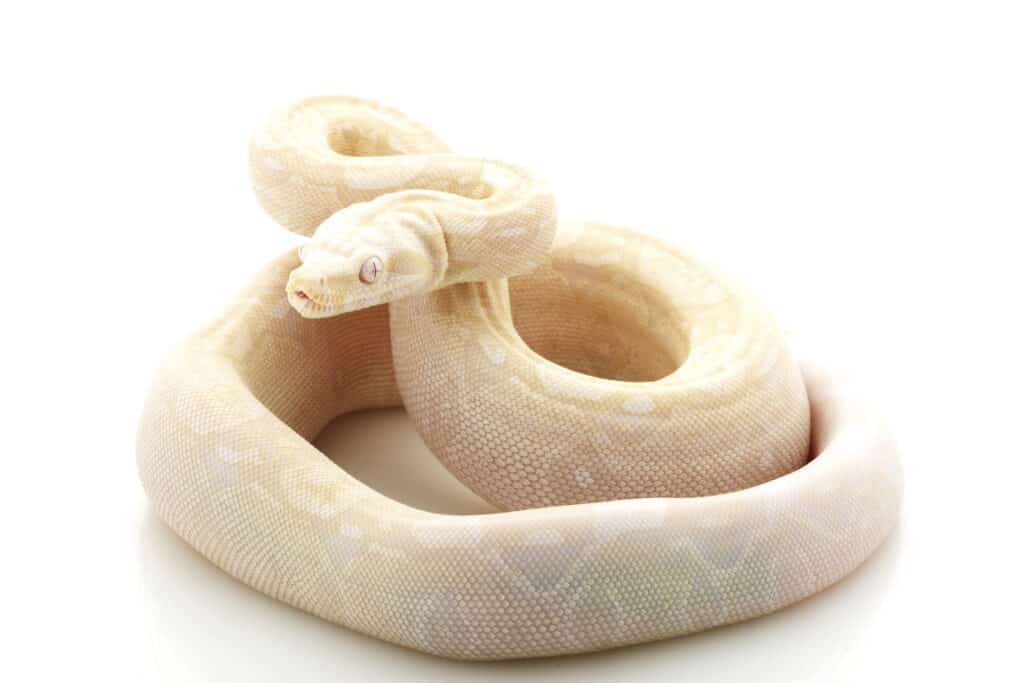Moonglow Boa
Boa constrictor
Moonglow boas are the result of mixing three genetic traits.
Advertisement
Moonglow Boa Scientific Classification
- Kingdom
- Animalia
- Phylum
- Chordata
- Class
- Reptilia
- Order
- Squamata
- Family
- Boidae
- Genus
- Boa
- Scientific Name
- Boa constrictor
Read our Complete Guide to Classification of Animals.
Moonglow Boa Conservation Status
Moonglow Boa Facts
- Prey
- Rats, mice, birds, rabbits, chickens
- Main Prey
- Rodents
- Name Of Young
- Neoates, snakelet
- Group Behavior
- Solitary
- Solitary except during mating season
- Fun Fact
- Moonglow boas are the result of mixing three genetic traits.
- Most Distinctive Feature
- White or nearly white
- Gestation Period
- 100-120 days
- Litter Size
- 10-65
- Diet
- Omnivore
- Lifestyle
- Diurnal/Nocturnal
- Favorite Food
- Depends on the snake's size, bigger boas can eat rabbits and chickens.
- Location
- South America
Moonglow Boa Physical Characteristics
- Color
- Yellow
- White
- Skin Type
- Scales
- Lifespan
- 20+ years
- Length
- Up to 13 feet
- Age of Sexual Maturity
- 2-4 years
- Venomous
- No
- Aggression
- Low
View all of the Moonglow Boa images!
“Moonglow boa constrictors are designer boa morphs that are white or nearly white.“
This white snake is similar to designer morphs of other species like ball pythons, in that breeders select snakes with specific genetic color and pattern mutations to breed together. Moonglow boas were first bred in the late 1990s and have since become popular color morphs for reptile keepers.
Incredible Moonglow Boa Facts
- This morph results from breeders combining snakes with three genes: hypomelanistic, anerythristic type I, and albino.
- Most boa morphs are from Boa imperator, but many snakes are mixed with Boa constrictor and B. imperator.
- Type I and type II anerythristic genes aren’t compatible and usually result in normal patterns and colors instead of a ”super” anerythristic.
Scientific Name and Classification
Like most of the boa morphs, this one originated in the Boa imperator species. However, they are closely related to snakes from the Boa constrictor species. The only way to be certain that your new pet snake is from a given species is to do genetic testing.
Identifying the Moonglow Boa: Appearance
Boa constrictors are large, heavy nonvenomous snakes that, as their name suggests, constrict their prey to subdue it before swallowing it whole. Some boas can grow to 13 feet long, but most of the captive-bred morphs come from stock that doesn’t get quite so big.
These snakes have many sharp, recurved teeth, strong jaws, and vertical pupils. Like other boas, they have heat-sensitive pits lining their lip that they use to locate warm-blooded prey.
Wild boa constrictors have a base color of tan or gray with brown saddle markings that become red to red-orange at the tail. Depending on the locality, these snakes vary from having rich chocolate saddles to very faded saddles, similar to the hypomelanistic trait in captive-bred boas.
About the Moonglow Boa
Moonglow boas are a specialty morph resulting from three different color mutation genes. In the 1990s, ball python breeders were capable of producing an all-white snake with blue eyes, but boa breeders could do no such thing. This motivated breeders to experiment with the following:
- Hypomelanistic trait- creates faded patterns and reduced reds.
- Anerythristic gene- removes reds.
- Albino gene- removes reds and reduces the pattern.
When moonglow boas are born, they’re nearly white and become more yellow as they age.

Moonglow boas are a specialty morph resulting from three different color mutation genes.
©fivespots/Shutterstock.com
Identifying the Moonglow Boa: Behavior
Most captive-bred moonglow boas are pretty relaxed. Babies are usually snappier than adults, but with time and proper handling, most of them settle down and become a joy to handle.
Like most boa species, moonglow boas are primarily nocturnal but can be active anytime, day or night. This is why having a defined night/day cycle in their habitat is vital.
Boas can be active hunters, but they’re primarily ambush predators. Neonates need to eat weekly, but adults only need to eat every few weeks. While hunting, they sit motionless, waiting for their meal.
Moonglow Boa Habitat
Surprisingly, a proper habitat for a Moonglow boa costs more than the snake. However, spending the money on a great enclosure means a healthier pet. A snake with improper conditions is more likely to become ill or have a shortened lifespan, so setting up a habitat before you get your snake is a must.
Boas are semi-arboreal and spend as much time in the trees as they do on the ground. Larger snakes probably won’t climb much, but they still need climbing opportunities. Depending on the genetics your Moonglow boa has in its background (the breeder should know), your snake may grow to over 10 feet and need space to move. Keeping them in smaller enclosures when they’re young is fine. However, as the snake grows, the enclosure will need to be replaced with a larger one. It may make more sense to start with the larger enclosure and provide lots of hiding places for the young snake to feel safe.
Lighting, heating, and humidity are important because snakes cannot adapt to changing conditions as easily as a dog or a cat. Boa constrictors are native to central and South America, with tropical or near tropical conditions all year long.
Moonglow Boa Diet
Wild boa constrictors eat a variety of smaller animals like rats, mice, rabbits, birds, and small deer species. In Florida, small pets like cats and dogs sometimes fall prey to invasive boas and pythons.
Pet boas primarily eat rats and mice until they get big enough for rabbits and chickens. However, frozen food is available from suppliers, so all you have to do is thaw and reheat it. That said, some people feed live prey to their snakes too. However, this increases the likelihood of injury.
Predators, Threats, Conservation, and Population
This snake isn’t found in the wild because it’s a captive-bred designer morph. It’s unclear how many of this morph are out there, but it is a popular choice among snake keepers. There are usually a few available on Morphmarket for sale.
Wild boa constrictors, both of the Boa constrictor and the Boa imperator species, are listed as species of least concern by the IUCN Redlist of Threatened Species. Some wild populations are declining, especially those on islands. Yet, most aren’t considered threatened or near threatened.
Larger animals like jaguars, ocelots, birds of prey, and other snakes prey on wild boa constrictors. Thankfully, moonglow boas have all been bred specifically for the pet trade, keeping them safe from predation.
Reproduction, Babies, and Lifespan
Moonglow boa constrictors mature at two to four years and can live to be more than 20 years old. After females mate, the babies develop for 100 to 120 days until they’re born. After birth, they’re fully independent and typically about 15 inches long.
Most breeders keep the babies for several months before sending them to their new homes, allowing them to become solidly established.
Related Animals
View all 164 animals that start with MMoonglow Boa FAQs (Frequently Asked Questions)
What do moonglow boas eat?
Like their wild counterparts, moonglow boas enjoy a variety of small mammals like rats, mice, and rabbits. They’ll also eat birds.
Are moonglow boas aggressive?
Moonglow boas are not typically aggressive. Because they’re captive-bred, they’re accustomed to being handled. As long as you handle them gently, they’re pretty docile.
Are moonglow boas venomous?
Like all boas, these snakes are nonvenomous.
Where can you find moonglow boas?
People typically purchase moonglow boas from breeders. There may be a few in rescue, but they’re usually purchased by dedicated keepers.
Thank you for reading! Have some feedback for us? Contact the AZ Animals editorial team.
Sources
- Dubia Roaches, Available here: https://dubiaroaches.com/blogs/how-to-guides/how-to-set-up-a-boa-constrictor-terrarium
- IUCN Redlist , Available here: https://www.iucnredlist.org/species/203879/2771951
- IUCN Redlist , Available here: https://www.iucnredlist.org/species/197462/2486405
















